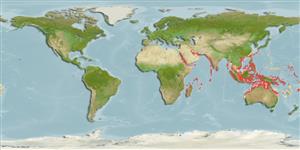Common names from other countries
>
Acanthuriformes (Surgeonfishes) >
Siganidae (Rabbitfishes)
Etymology: Siganus: Latin, siganus = a fish, rabbit fish; by the similarity of the nose (Ref. 45335).
More on author: Forsskål.
Environment: milieu / climate zone / depth range / distribution range
Ecologia
marinhas associadas(os) a recifes; intervalo de profundidade 1 - ? m (Ref. 9710), usually 5 - 30 m (Ref. 27115). Tropical; 24°C - 28°C (Ref. 27115); 30°N - 35°S
Indian Ocean: Red Sea and East Africa to the Andaman Sea.
Tamanho / Peso / Idade
Maturity: Lm ? range ? - ? cm
Max length : 40.0 cm TL macho/indeterminado; (Ref. 4407); common length : 35.0 cm TL macho/indeterminado; (Ref. 9813)
Espinhos dorsais (total) : 13; Raios dorsais (total) : 10; Espinhos anais: 7; Raios anais : 9; Vértebras: 13. Indian Ocean subspecies. S. s. laqueus greyish green with head and body covered with chocolate brown spots; in S. s. stellatus, background color is yellowish. Trailing edges of soft parts of dorsal and anal fins, perimeter of caudal fin and a saddle over the caudal peduncle are markedly paler than the rest. Silvery iris, tinted brown or green, with 10 equally spaced spots. Spines stout; pungent only in juveniles. Preopercular angle 92°-103°. Strong scales cover the cheeks. Usually midline of thorax fully scaled, but pelvic ridges sometimes without scales.
Common in coral reefs; juveniles enter weedy estuaries (Ref. 4407). Juveniles and subadults form schools, adults in pairs. Adults feed on benthic seaweeds (Ref. 9813). Anterolateral glandular grooves with venom gland (Ref. 57406).
Ciclo de vida ou comportamento de acasalamento
Maturities | Reprodução | Spawnings | Egg(s) | Fecundities | Larvas
Woodland, D.J., 1990. Revision of the fish family Siganidae with descriptions of two new species and comments on distribution and biology. Indo-Pac. Fish. (19):136 p. (Ref. 1419)
Status na Lista Vermelha da UICN (Ref. 130435)
CITES (Ref. 128078)
Not Evaluated
Uso pelos humanos
Pescarias: espécies comerciais; Aquário: Espécies comerciais
Ferramentas
Relatórios especiais
Baixar XML
Fontes da internet
Estimates based on models
Preferred temperature (Ref.
115969): 25.3 - 29.1, mean 28.1 (based on 1240 cells).
Índice de diversidade filogenética (Ref.
82804): PD
50 = 0.5000 [Uniqueness, from 0.5 = low to 2.0 = high].
Bayesian length-weight: a=0.01514 (0.00816 - 0.02809), b=2.99 (2.83 - 3.15), in cm Total Length, based on LWR estimates for this species & Genus-body shape (Ref.
93245).
Nível Trófico (Ref.
69278): 2.7 ±0.30 se; based on food items.
Resiliência (Ref.
120179): Elevada, tempo mínimo de duplicação da população menor que 15 meses (Preliminary K or Fecundity.).
Fishing Vulnerability (Ref.
59153): Low to moderate vulnerability (30 of 100).
